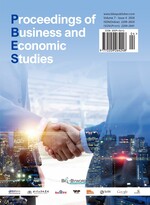Abstract
This paper analyzes factors that explain company layoffs, given the individual layoff data in 2021, China. Using the Probit regression model, we find that gender inequality exists in layoffs, an employee’s work experience becomes less critical in the company’s layoff decisions, and how an employee’s health reasons affect work affects its probability of being laid off. Since we consider a significant endogeneity issue with education, using parents’ education as an instrumental variable suggests that political status cannot be a significant advantage for employees to lower the chance of being laid off. Moreover, evidence implies that policymakers encouraging the pursuit of higher educational degrees can foster stability in the labor market.
References
Okatenko A, 2010, The Impact of the Reason for Layoff on the Subsequent Unemployment Duration. Annals of Economics and Statistics, 99/100: 285–315. https://doi.org/10.2307/41219168
Blau FD, Kahn LM, 1981, Causes and Consequences of Layoffs. Economic Inquiry, 19(2): 270–296.
Roed K, Nordberg M, 2003, Temporary Layoffs and the Duration of Unemployment. Labour Economics, 10(3): 381–398. https://doi.org/10.1016/S0927-5371(02)00118-5
Chebolu S, 2021, Analysis of Reasons for Layoffs by Technology Startups during Covid-19 Pandemic. Shanlax International Journal of Management, 8(S1): 58–61. https://doi.org/10.34293/management.v8iS1-Feb.3758
Ne’eman A, Maestas N, 2023, How has COVID-19 Impacted Disability Employment? Disabil Health J, 16(2): 101429. https://doi.org/10.1016/j.dhjo.2022.101429
Cornfield DB, 1983, Chances of Layoff in a Corporation: A Case Study. Administrative Science Quarterly, 28(4): 503–520. https://doi.org/10.2307/2393006
Pan W, Ost B, 2014, The Impact of Parental Layoff on Higher Education Investment. Economics of Education Review, 42: 53–63. https://doi.org/10.1016/j.econedurev.2014.06.006
Couch KA, Fairlie RW, Xu H, 2020, Early Evidence of the Impacts of COVID-19 on Minority Unemployment. J Public Econ, 192: 104287. https://doi.org/10.1016/j.jpubeco.2020.104287
Goldhaber D, Strunk KO, Brown N, et al., 2016, Lessons Learned from the Great Recession: Layoffs and the RIF-Induced Teacher Shuffle. Educational Evaluation and Policy Analysis, 38(3): 517–548.
Joungtrakul J, 2019, Thai Higher Education in Crisis: Lay Off of University Staff on the Way. Journal of Business Administration and Social Sciences Ramkhamhaeng University, 2(1): 1–16.
Cameron AC, Trivedi PK, 2005, Microeconometrics: Methods and Application. Cambridge University Press, Cambridge. https://doi.org/10.1017/CBO9780511811241
Dias FA, 2021, The Racial Gap in Employment and Layoffs during COVID-19 in the United States: A Visualization. Socius, 7. https://doi.org/10.1177/2378023120988397
Sunarsi D, Jasmani, Suryani NL, et al., 2020, Covid-19 Pandemic Analysis toward Productivity Giving Layoffs Effect in the Company of Industrial Sector around South Tangerang. Prosiding ICoISSE, 1(1).
Liu S, Zhang X, Wan Y, 2023, Retirement Spillover Effects on Spousal Health in Urban China. Journal of Family and Economic Issues. https://doi.org/10.1007/s10834-023-09935-7
Wooldridge JM, 2019, Introductory Econometrics: A Modern Approach. 7th Edition. Cengage Learning, Massachusetts.
